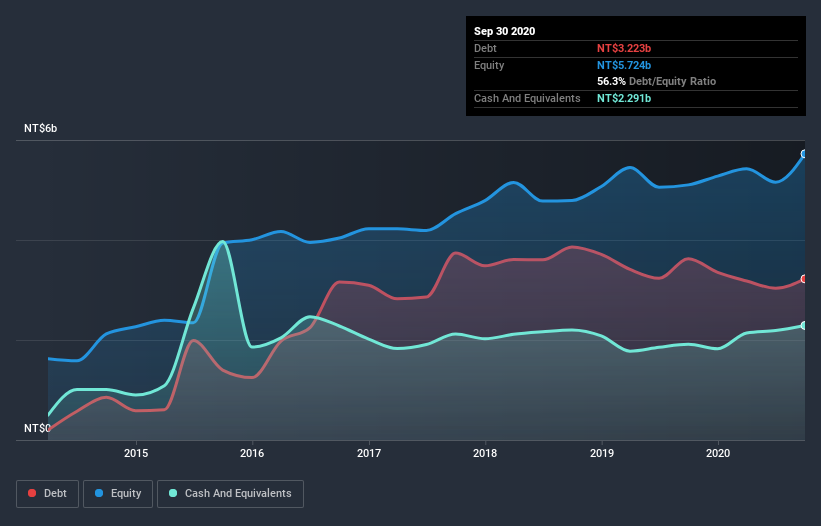KMC (Kuei Meng) International (GTSM:5306) Could Easily Take On More Debt

Warren Buffett famously said, 'Volatility is far from synonymous with risk.' When we think about how risky a company is, we always like to look at its use of debt, since debt overload can lead to ruin. Importantly, KMC (Kuei Meng) International Inc. (GTSM:5306) does carry debt. But the real question is whether this debt is making the company risky.
When Is Debt Dangerous?
Generally speaking, debt only becomes a real problem when a company can't easily pay it off, either by raising capital or with its own cash flow. If things get really bad, the lenders can take control of the business. However, a more frequent (but still costly) occurrence is where a company must issue shares at bargain-basement prices, permanently diluting shareholders, just to shore up its balance sheet. Of course, the upside of debt is that it often represents cheap capital, especially when it replaces dilution in a company with the ability to reinvest at high rates of return. When we think about a company's use of debt, we first look at cash and debt together.
View our latest analysis for KMC (Kuei Meng) International
What Is KMC (Kuei Meng) International's Debt?
You can click the graphic below for the historical numbers, but it shows that KMC (Kuei Meng) International had NT$3.22b of debt in September 2020, down from NT$3.62b, one year before. On the flip side, it has NT$2.29b in cash leading to net debt of about NT$932.1m.

A Look At KMC (Kuei Meng) International's Liabilities
The latest balance sheet data shows that KMC (Kuei Meng) International had liabilities of NT$2.18b due within a year, and liabilities of NT$2.49b falling due after that. On the other hand, it had cash of NT$2.29b and NT$1.37b worth of receivables due within a year. So its liabilities outweigh the sum of its cash and (near-term) receivables by NT$1.02b.
Given KMC (Kuei Meng) International has a market capitalization of NT$24.4b, it's hard to believe these liabilities pose much threat. Having said that, it's clear that we should continue to monitor its balance sheet, lest it change for the worse.
In order to size up a company's debt relative to its earnings, we calculate its net debt divided by its earnings before interest, tax, depreciation, and amortization (EBITDA) and its earnings before interest and tax (EBIT) divided by its interest expense (its interest cover). The advantage of this approach is that we take into account both the absolute quantum of debt (with net debt to EBITDA) and the actual interest expenses associated with that debt (with its interest cover ratio).
KMC (Kuei Meng) International has a low net debt to EBITDA ratio of only 0.47. And its EBIT easily covers its interest expense, being 254 times the size. So you could argue it is no more threatened by its debt than an elephant is by a mouse. Also positive, KMC (Kuei Meng) International grew its EBIT by 27% in the last year, and that should make it easier to pay down debt, going forward. The balance sheet is clearly the area to focus on when you are analysing debt. But it is future earnings, more than anything, that will determine KMC (Kuei Meng) International's ability to maintain a healthy balance sheet going forward. So if you're focused on the future you can check out this free report showing analyst profit forecasts.
Finally, a business needs free cash flow to pay off debt; accounting profits just don't cut it. So we clearly need to look at whether that EBIT is leading to corresponding free cash flow. Over the most recent three years, KMC (Kuei Meng) International recorded free cash flow worth 79% of its EBIT, which is around normal, given free cash flow excludes interest and tax. This free cash flow puts the company in a good position to pay down debt, when appropriate.
Our View
The good news is that KMC (Kuei Meng) International's demonstrated ability to cover its interest expense with its EBIT delights us like a fluffy puppy does a toddler. And the good news does not stop there, as its conversion of EBIT to free cash flow also supports that impression! It looks KMC (Kuei Meng) International has no trouble standing on its own two feet, and it has no reason to fear its lenders. For investing nerds like us its balance sheet is almost charming. There's no doubt that we learn most about debt from the balance sheet. But ultimately, every company can contain risks that exist outside of the balance sheet. To that end, you should be aware of the 2 warning signs we've spotted with KMC (Kuei Meng) International .
If you're interested in investing in businesses that can grow profits without the burden of debt, then check out this free list of growing businesses that have net cash on the balance sheet.
If you decide to trade KMC (Kuei Meng) International, use the lowest-cost* platform that is rated #1 Overall by Barron’s, Interactive Brokers. Trade stocks, options, futures, forex, bonds and funds on 135 markets, all from a single integrated account. Promoted
Valuation is complex, but we're here to simplify it.
Discover if KMC (Kuei Meng) International might be undervalued or overvalued with our detailed analysis, featuring fair value estimates, potential risks, dividends, insider trades, and its financial condition.
Access Free AnalysisThis article by Simply Wall St is general in nature. It does not constitute a recommendation to buy or sell any stock, and does not take account of your objectives, or your financial situation. We aim to bring you long-term focused analysis driven by fundamental data. Note that our analysis may not factor in the latest price-sensitive company announcements or qualitative material. Simply Wall St has no position in any stocks mentioned.
*Interactive Brokers Rated Lowest Cost Broker by StockBrokers.com Annual Online Review 2020
Have feedback on this article? Concerned about the content? Get in touch with us directly. Alternatively, email editorial-team (at) simplywallst.com.
About TWSE:5306
KMC (Kuei Meng) International
Manufactures and sells various types of chains, motorcycle components, and vehicle components in Asia, Europe, and the United States.
Flawless balance sheet, undervalued and pays a dividend.
Market Insights
Community Narratives


